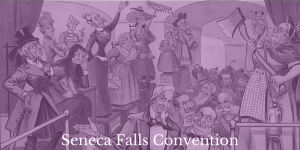Seneca Falls Convention

The student will examine primary sources about the Seneca Falls Convention in 1848 to understand why a women’s rights movement was necessary to gain greater rights for women.
15 minutes (Extend the lesson to 45 minutes by having students create a skit on the proceedings of the Convention. Assign roles to students by having them play the part of convention participants, journalists, and those opposed to the convention.)
Students will understand the Seneca Falls Convention in 1848 and why the women's rights movement was necessary.
For gifted/honors students or if class time is limited, have the students research the background information ahead of time (previous class period) and bring their research to class. You can also print out the websites and distribute to the collaborative groups (see below).
- Documents from Library of Congress and Other Sources (see pdf)
- The “Observe, Reflect, Question” Tool via The Library of Congress
- Starter/Hook: On the board, write “Reasons Why Children Should or Should Not Be Allowed to Vote” to initiate a discussion. Have students give their own opinions about why children (18 and under) should or should not be allowed to have a voice in picking their government. After the discussion, explain to students that the same reasons they listed for youth voting were used regarding whether women should vote.
- Direct Instruction:
- Provide background on women’s place in 19th century American society to the class. Explain to them that:
- Women were limited in freedoms and rights in the 19th century
- A women’s movement was necessary to gain greater rights and suffrage
- Men and women reformers both took part in the Seneca Falls Convention
- Opinions regarding women’s rights differed in the 19th century
- Use the NWHM’s “Crusade for the Vote” to provide background information:
- Provide background on women’s place in 19th century American society to the class. Explain to them that:
- Guided Practice:
- Divide students into groups of six and assign a primary source (see below).
- Tell each group to Observe, Reflect, and Question using the ORQ Tool from the Library of Congress. Each group will examine a specific source for evidence related to the central question: Why was a women’s rights movement necessary?
- Explain to students that some of the sources reflect positively on the convention and others are opposed to the convention.
- Once each group has examined the sources, write on the board Observe, Reflect, and Question. Have students send a representative from each group to record their observations, reflections, and questions. Discuss as a class.
Students will research one of the participants of the Seneca Falls Convention and create and short presentation to show the class during the next class period.
UCLA Social Studies Standard 1C: Specify the issues raised by various women and how mainstream Progressives responded to them. [Consider multiple perspectives]
UCLA Social Studies Standards Available Here
Common Core Alignment:
Cite specific textual evidence to support analysis of primary and secondary sources, attending to such features as the date and origin of the information.
CCSS.ELA-LITERACY.RH.11-12.1
Cite specific textual evidence to support analysis of primary and secondary sources, connecting insights gained from specific details to an understanding of the text as a whole.
